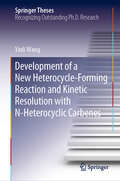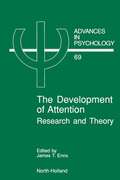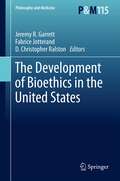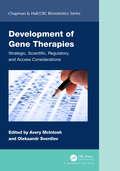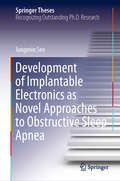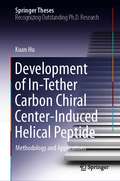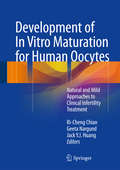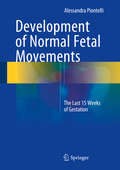- Table View
- List View
Development, Implementation and Evaluation of Curricula in Nursing and Midwifery Education
by Ingrid Darmann-Finck Karin ReiberThis book provides a review of central contributions from a variety of countries, and is intended to enhance and expand the national professional dialogue on curricula in nursing and midwifery education. All questions of a general nature related to the topic of “curricula” are dealt within the framework of this internationally oriented anthology. Though the contributions may address challenges concerning curriculum work in a specific country, they have been selected and structured to ensure their applicability to other countries. The book’s main goals are to highlight the various phases and aspects of curriculum development and to offer a broad international perspective on the topic. It provides an overview of the international status quo of the theory development and seeks to promote an ongoing international discussion and cooperation in curriculum work in nursing and midwifery education. When there are major changes in nursing and midwifery care, nursing (and midwifery) education has to change, too. Curricula offer an important basis for shaping educational processes at vocational schools and universities. The discussion of nursing and midwifery curricula is currently primarily taking place at the national level. The book shows that the approaches and instruments used in the development, construction, implementation and evaluation of curricula in nursing and midwifery education in different countries relate to very similar theoretical foundations. This finding can be seen as a confirmation of the national approaches. Although the book chiefly focuses on nursing education, examples from midwifery education are also included, so as to foster international and interprofessional cooperation.
Development in Adolescence: Psychological, Social and Biological Aspects
by J. J. Werff ten Bosch A. Bot C. B. Hindley W. EveraerdDevelopment of a New Heterocycle-Forming Reaction and Kinetic Resolution with N-Heterocyclic Carbenes (Springer Theses)
by Yinli WangIn this book, the author focuses on exploring new organocatalytic transformations under operationally simple and environmentally friendly reaction conditions. Two new types of catalytic reactions promoted by N-heterocyclic carbenes (NHCs) are described. The oxa- and azacycle-forming reactions of sulfonylalkynols and sulfonylalkynamides are broadly considered to be a new type of activation mode in NHC chemistry, wherein the bond formation with internal O- and N-nucleophiles occurs at the γ-position of the propargyl sulfones with 1,2-sulfonyl migration. The resulting oxa- and azacycles are core structures in many biologically significant compounds and medicinally important agents. In addition, the book develops the chiral NHC-catalyzed kinetic resolution of α-hydroxy carboxylic acid derivatives based on chiral recognition of the substrate–cocatalyst complex. In this carboxylate cocatalyst-assisted chiral acylation, the reaction rate acceleration and selectivity enhancement are interpreted in terms of the reversible complexation of the substrate and carboxylate cocatalyst, which is verified by control experiments and measured using analytical methods. The findings described here reveal a promising new aspect of not only NHC catalysis but also identifying novel catalysis systems.
The Development of a New Triphasic Oral Contraceptive: The Proceedings of a Special Symposium held at the 10th World Congress on Fertility and Sterility, Madrid July 1980
by R. B. Greenblatt, J. Cortés-Prieto and A. Campos-da-PazDevelopment of Antibody-Based Therapeutics: Translational Considerations
by Scott L. Klakamp Gadi G. Bornstein Mohammad A. TabriziWith a key focus on recent developments and advances in the field, this book provides in-depth coverage of topics fundamental to the development of targeted therapeutics. The expansion of targeted modalities in rapidly evolving therapeutic areas, such as immune-oncology, and developments with respect to combination therapies, novel technologies, and the therapeutic application of antibody-drug conjugates, are presented. Additionally, the book builds upon topics discussed in the first edition (2012) where recent innovations warrant elaboration. This, the second edition of Development of Antibody-Based Therapeutics: Translational Considerations, represents a comprehensive evaluation of progress in the field, which sits alongside the first edition to inform, in detail, professional and academic researchers, as well as graduate students.
Development of Antibody-Based Therapeutics: Translational Considerations
by Mohammad A. Tabrizi, Gadi G. Bornstein and Scott L. KlakampTranslational strategies for development of antibody-based therapeutics should allow understanding of the relationship between the ‘unit dose’ and ‘unit effect’ with respect to both beneficial and deleterious effects from early stages of development. The flow of information from later to earlier stages of development should provide opportunities to facilitate selection of more effective novel and next-generation drug candidates. Selection and evaluation of relevant biomarkers in early preclinical development in "relevant" animal models should allow for identifying potential risks to humans and establishing safe First-In-Human (FIH) dosing strategies. Hence, integration of knowledge with respect to target antigen properties such as antigen distribution, expression profile, kinetic properties, target pharmacology, antigen isoforms and pharmacological redundancy in health and disease, as well as antibody design criteria, such as antibody isotype, affinity, PK/PD and safety is a critical necessity for the design of effective translational strategies. Additionally, these factors will further offer critical differentiating characteristics for next-generation antibodies, and novel technologies prove instrumental in generation of biosuperior antibody candidates for market entry. This book will examine many important considerations necessary for the design of effective translational strategies during the development of antibody-based therapeutics.
The Development of Attention: Research and Theory (ISSN #Volume 69)
by J. T. EnnsThis volume presents an up-to-date review of developmental aspects of human attention by leading researchers and theorists. The papers included in the first section consider the ways in which newborns are pretuned to visual, auditory, linguistic, and social features of their environment, as well as how selectivity to these features changes in the first year of life. The following section examines properties of the visual and auditory world that are attention-getting for children. Developmental increases in capacity and strategy are also examined in this section through the study of perception, memory, problem-solving and language. Section III explores several ways in which selective processing can fail in development (e.g. autism, hyperactivity, and psychopathy) while Section IV reports on those aspects of selectivity that are lost (and preserved) in the aging process.
The Development of Bioethics in the United States (Philosophy and Medicine #115)
by Jeremy R. Garrett, Fabrice Jotterand and D. Christopher RalstonIn only four decades, bioethics has transformed from a fledgling field into a complex, rapidly expanding, multidisciplinary field of inquiry and practice. Its influence can be found not only in our intellectual and biomedical institutions, but also in almost every facet of our social, cultural, and political life. This volume maps the remarkable development of bioethics in American culture, uncovering the important historical factors that brought it into existence, analyzing its cultural, philosophical, and professional dimensions, and surveying its potential future trajectories. Bringing together a collection of original essays by seminal figures in the fields of medical ethics and bioethics, it addresses such questions as the following: - Are there precise moments, events, socio-political conditions, legal cases, and/or works of scholarship to which we can trace the emergence of bioethics as a field of inquiry in the United States? - What is the relationship between the historico-causal factors that gave birth to bioethics and the factors that sustain and encourage its continued development today? - Is it possible and/or useful to view the history of bioethics in discrete periods with well-defined boundaries? - If so, are there discernible forces that reveal why transitions occurred when they did? What are the key concepts that ultimately frame the field and how have they evolved and developed over time? - Is the field of bioethics in a period of transformation into biopolitics? Contributors include George Annas, Howard Brody, Eric J. Cassell, H. Tristram Engelhardt Jr., Edmund L. Erde, John Collins Harvey, Albert R. Jonsen, Loretta M. Kopelman, Laurence B. McCullough, Edmund D. Pellegrino, Warren T. Reich, Carson Strong, Robert M. Veatch, and Richard M. Zaner.
Development of Biopharmaceutical Drug-Device Products (AAPS Advances in the Pharmaceutical Sciences Series #35)
by Feroz Jameel John W. Skoug Robert R. NesbittThe biotechnology/biopharmaceutical sector has tremendously grown which led to the invention of engineered antibodies such as Antibody Drug Conjugates (ADCs), Bispecific T-cell engager (BITES), Dual Variable Domain (DVD) antibodies, and fusion proteins that are currently being used as therapeutic agents for immunology, oncology and other disease conditions. Regulatory agencies have raised the bar for the development and manufacture of antibody-based products, expecting to see the use of Quality by Design (QbD) elements demonstrating an in-depth understanding of product and process based on sound science. Drug delivery systems have become an increasingly important part of the therapy and most biopharmaceuticals for self-administration are being marketed as combination products. A survey of the market indicates that there is a strong need for a new book that will provide “one stop shopping” for the latest information and knowledge of the scientific and engineering advances made over the last few years in the area of biopharmaceutical product development. The new book entitled Development of Biopharmaceutical Drug Device Products is a reference text for scientists and engineers in the biopharmaceutical industry, academia or regulatory agencies. With insightful chapters from experts in the field, this new book reviews first principles, covers recent technological advancements and provides case studies and regulatory strategies relating to the development and manufacture of antibody-based products. It covers topics such as the importance of early preformulation studies during drug discovery to influence molecular selection for development, formulation strategies for new modalities, and the analytical techniques used to characterize them. It also addresses important considerations for later stage development such as the development of robust formulations and processes, including process engineering and modeling of manufacturing unit operations, the design of analytical comparability studies, and characterization of primary containers (pre-filled syringes and vials).Finally, the latter half of the book reviews key considerations to ensure the development and approval of a patient-centered delivery system design. This involves the evolving regulatory framework with perspectives from both the US and EU industry experts, the role of international standards, design control/risk management, human factors and its importance in the product development and regulatory approval process, as well as review of the risk-based approach to bridging between devices used in clinical trials and the to-be-marketed device. Finally, case studies are provided throughout.The typical readership would have biology and/or engineering degrees and would include researchers, scientific leaders, industry specialists and technology developers working in the biopharmaceutical field.
Development of Biopharmaceutical Parenteral Dosage Forms
by Burton I. Korelitz Cosimo PranteraThis up-to-the-minute reference delineates-in a systematic fashion-the appropriate, sequential steps for the formulation of safe, effective, stable, and marketable liquid parenteral biopharmaceutical products-covering fundamentals and essential pathways for each phase as well as its purpose, function, and relation to other stages in the product dev
Development of Chemistry-Based Screening Platform for Access to Mirror-Image Library of Natural Products (Springer Theses)
by Taro NoguchiThis thesis mainly describes the development of a screening process for a mirror-image library of chiral natural products. It demonstrates how, by using mirror-image proteins for the screening of available natural products, unavailable mirror-image isomers of natural products can be screened in a mirror process. Moreover, as mirror-image isomers including target proteins and natural products are mainly prepared by means of chemical synthesis, the screening strategy presented here suggests the importance of organic chemistry. Natural products are commonly used as valuable resources for drug discovery. However, as they are mostly produced as single enantiomeric forms, researchers have tested only natural products bearing one stereochemistry available in nature. As natural products and their enantiomers have identical physicochemical properties and different biological activities, mirror-image isomers of natural products are promising candidates for novel medicinal resources. In an effort to identify anticancer agents from the mirror-image library, chemical protein syntheses of some target oncoproteins, MDM2, MDMX and Grb2, and their applications to the chemical array screening process were achieved. In the course of this process the NP843 enantiomer, which is the enantiomer of an α-tocopherol derivative, was successfully identified as a novel MDM2-p53 interaction inhibitor. These results clearly show that a mirror-image library of chiral natural products represents an invaluable medicinal resource. Accordingly, the chemistry-based screening strategy described in this thesis will be of great interest to a broad range of chemists involved in natural product, medicinal, and synthetic chemistry.
The Development of Coping: Stress, Neurophysiology, Social Relationships, and Resilience During Childhood and Adolescence (J-b Cad Single Issue Child And Adolescent Development Ser. #94)
by Ellen A. Skinner Melanie J. Zimmer-GembeckThis book traces the development of coping from birth to emerging adulthood by building a conceptual and empirical bridge between coping and the development of regulation and resilience. It offers a comprehensive overview of the challenges facing the developmental study of coping, including the history of the concept, critiques of current coping theories and research, and reviews of age differences and changes in coping during childhood and adolescence. It integrates multiple strands of cutting-edge theory and research, including work on the development of stress neurophysiology, attachment, emotion regulation, and executive functions.In addition, chapters track how coping develops, starting from birth and following its progress across multiple qualitative shifts during childhood and adolescence. The book identifies factors that shape the development of coping, focusing on the effects of underlying neurobiological changes, social relationships, and stressful experiences. Qualitative shifts are emphasized and explanatory factors highlight multiple entry points for the diagnosis of problems and implementation of remedial and preventive interventions.Topics featured in this text include:Developmental conceptualizations of coping, such as action regulation under stress.Neurophysiological developments that underlie age-related shifts in coping.How coping is shaped by early adversity, temperament, and attachment.How parenting and family factors affect the development of coping. The role of coping in the development of psychopathology and resilience.The Development of Coping is a must-have resource for researchers, professors, and graduate students as well as clinicians and related professionals in developmental, clinical child, and school psychology, public health, counseling, personality and social psychology, and neurophysiological psychology as well as prevention and intervention science.
Development of Electronic Aids for the Visually Impaired: Proceedings of a workshop on the Rehabilitation of the Visually Impaired, held at the Institute for Research on Electromagnetic Waves of the National Research Council, Florence, Italy. Sponsored by the Commission of the European Communities as advised by the Committee on Medical and Public Health Research (Documenta Ophthalmologica Proceedings Series #47)
by P. L. EmilianiThis book is based on the papers presented at the Workshop on "Rehabilitation of the Visually Impaired" held in Flo rence at the Institute for the Research on Electromagnetic Waves of the Italian Research Council on April 4-6, 1984. The Workshop, sponsored by the Committee for Medical and Public Health Research of the Commission of the European Communities, was meant to exchange ideas about the need, importance and feasibility of a European cooperation in the field of visual impairment and to identify promising research areas, where current national activities could take advantage of such a collaboration in order to increase their efficiency. In particular, it dealt with the develop ment and use of technical aids (mainly based on computers and signal processing techniques) and with the elaboration, evaluation and standardization of new methods and tests. The attendance was multidisciplinary, including researchers from the fields of technology, medicine and psychology and representatives from organizations involved in the rehabi litation of the visually impaired. Five technical sessions were organized, dealing with the following topics: automatic production of Braille and systems for paperless Braille, aids for reading and for the interaction with coded informa tion sources, low vision aids, transduction of visual infor mation into a tactile representation, mobility aids. Three different application sectors were mainly considered: education and culture, vocational training, mobility. A final session was devoted to a discussion in working groups. The results are briefly outlined in the following concise report of the Workshop.
Development of Gene Therapies: Strategic, Scientific, Regulatory, and Access Considerations (Chapman & Hall/CRC Biostatistics Series)
by Avery McIntosh Oleksandr SverdlovCell and gene therapies have become the third major drug modality in pharmaceutical medicine of the 21st century after low molecular weight and antibody drugs. The gene therapy (GTx) field is rapidly advancing, and yet there are still fundamental scientific questions that remain to be answered. Development of GTx products poses unique challenges and opportunities for drug developers. However, there is lack of a systematic exposition of the GTx product development and the pivotal role of the biostatistician in this process. Development of Gene Therapies: Strategic, Scientific, and Regulatory, and Access Considerations attempts to summarize the current state-of-the-art strategic, scientific, statistical, and regulatory aspects of GTx development. Intended to provide an exposition to the GTx new product development through peer-reviewed papers written by subject matter experts in this emerging field, this book will be useful for researchers in gene therapy drug development, biostatisticians, regulators, patient advocates, graduate students, and the finance and business development community . Key Features: A collection of papers covering a wide spectrum of topics in gene therapies (GTx), written by leading subject matter experts. An exposition of the core principles of GTx product development, emerging business models, industry standards, best practices, and regulatory pathways. An exposition of statistical and innovative modeling tools for design and analysis of clinical trials of GTx. Insights into commercial models, access hurdles, and health economics of gene therapies. Case studies of successful GTx approvals from core team members that developed the first two FDA-approved AAV gene therapies: Luxturna and Zolgensma. A discussion of potential benefits and hurdles to be overcome for GTx in coming years from a multi-stakeholder perspective.
Development of Gene Therapies: Strategic, Scientific, Regulatory, and Access Considerations (Chapman & Hall/CRC Biostatistics Series)
Cell and gene therapies have become the third major drug modality in pharmaceutical medicine of the 21st century after low molecular weight and antibody drugs. The gene therapy (GTx) field is rapidly advancing, and yet there are still fundamental scientific questions that remain to be answered. Development of GTx products poses unique challenges and opportunities for drug developers. However, there is lack of a systematic exposition of the GTx product development and the pivotal role of the biostatistician in this process. Development of Gene Therapies: Strategic, Scientific, and Regulatory, and Access Considerations attempts to summarize the current state-of-the-art strategic, scientific, statistical, and regulatory aspects of GTx development. Intended to provide an exposition to the GTx new product development through peer-reviewed papers written by subject matter experts in this emerging field, this book will be useful for researchers in gene therapy drug development, biostatisticians, regulators, patient advocates, graduate students, and the finance and business development community . Key Features: A collection of papers covering a wide spectrum of topics in gene therapies (GTx), written by leading subject matter experts. An exposition of the core principles of GTx product development, emerging business models, industry standards, best practices, and regulatory pathways. An exposition of statistical and innovative modeling tools for design and analysis of clinical trials of GTx. Insights into commercial models, access hurdles, and health economics of gene therapies. Case studies of successful GTx approvals from core team members that developed the first two FDA-approved AAV gene therapies: Luxturna and Zolgensma. A discussion of potential benefits and hurdles to be overcome for GTx in coming years from a multi-stakeholder perspective.
The Development of Hearing: Its Progress and Problems (Studies in Development Paediatrics #2)
by S.R. YeatesThe frontispiece of this book is called 'The invisible handicap'. Most deaf children, with the exception of very unfortunate multiple-handicap children, look quite normal. The young babies who are sent to my clinics for confirm ation (or otherwise) of a hearing loss are very often handsome, delightful infants with no other problems. The deaf child only reveals his handicap when communi cation is attempted. At that point the picture changes. To an ill-informed observer this child, who had previously seemed quite normal and who had been seen to be playing normally, suddenl y appears' stu pid'. That, unhappily, is too often the attitude of the general public towards the deaf person. There is far too often a total misunderstanding of the problems of both the deaf child and the deaf adult. It must also be admitted that far too often the speech of the deaf is very ugly and when this is added to their difficulties in verbal comprehension we begin to understand why the attitude of the public at large is ill-judged, intolerant and occasionally even hostile. We must, therefore, aim for three goals. The first must be the ever-increasing education of hearing people about the problems of the deaf, with maximum attempts to involve them with the activities of the deaf community', which has evolved for self-protection and mutual help and under- 11 The development of hearing standing, and which must be opened up to sympathetic hearing people.
The Development of Immunologic Competence
by Domenico RibattiThis book traces significant aspects of the history of immunology, exploring the immune system and immunodeficiency. The author recounts human hematopoietic development, and how a distinction of the immune system into thymus-dependent and thymus-independent components has been demonstrated in different animal species, including amphibians, birds, and mammals. Other themes explored in this book include discoveries about the role of the thymus of the Bursa of Fabricius in the development of immunologic competence, and observations on the changes in the lymphoid organs after bursectomy and thymectomy in chickens. Readers will discover how the bursa provides a unique microenvironment for the proliferation and differentiation of B cells, while thymectomized and irradiated animals were deficient in lymphocytes that mediated inflammatory responses, as assessed by skin graft rejection, delayed-type hypersensitivity, and graft versus host reaction.A clear perspective for understanding several diseases and also the entire lymphoid system emerges through the experiments and extensive histopathological studies of patients with primary immunodeficiency diseases that are described in these chapters.Researchers in the life sciences, in biomedicine and the history of medicine will all find something of value in this highly engaging work. It will also appeal to those with an interest in public health and neurobiology.
Development of Implantable Electronics as Novel Approaches to Obstructive Sleep Apnea (Springer Theses)
by Jungmin SeoThis book addresses novel methods to treat a very popular disease, obstructive sleep apnea, based on a knowledge of an electrical engineering. Two approaches are given in the book using an upper-airway stimulation based on the pathogenesis of an obstructive sleep apnea. Implantable electronics are devised to control the tongue and the soft palate considering that they are the major pharyngeal muscles contributing to the apnea. First, for tongue control, a cuff electrode was designed and fabricated to stimulate the hypoglossal nerve, which innervates to the tongue muscle. Rare-earth magnets were embedded in the cuff for easy and repeatable installation of the electrode. For soft palate control, a palatal implant system was firstly developed to contract the soft palate muscle by applying electrical stimuli. Comprised of an implant, an intra-oral device, and an external controller, the palatal implant system is fully powered and controlled by means of wireless communication. The approaches were demonstrated in both in vitro and in vivo assessments, in collaboration with department of Otorhinolaryngology, Seoul National University Bundang Hospital.
Development of In-Tether Carbon Chiral Center-Induced Helical Peptide: Methodology and Applications (Springer Theses)
by Kuan HuThis book focuses on the development of stapled peptides, a novel molecular modality used to regulate aberrant intracellular protein–protein interactions (PPIs). The author designs and presents a novel helical peptide stabilization methodology by constructing a chiral cross-linker moiety, namely “chiral center induced peptide helicity (CIH)”. The book demonstrates that a precisely positioned carbon chiral center on tether can decisively determine the secondary structure of a peptide, and that the R-configured peptide is helical, while the S-configured peptide is non-helical. Further, it reports that helicity-enhanced R isomer peptides displayed significantly enhanced cell permeability and target binding affinity, as well as tumor inhibition efficiency, in comparison to S isomer peptides. The book will not only advance readers’ understanding of the basic principle of stapled peptides, but also accelerate the clinical transformation of stapled peptide drugs.
Development of In Vitro Maturation for Human Oocytes: Natural and Mild Approaches to Clinical Infertility Treatment
by Ri-Cheng Chian Geeta Nargund Jack Y. HuangAn ideal reference for infertility specialists and reproductive endocrinologists alike, this comprehensive text discusses current natural and mild approaches to in vitro fertilization (IVF) and the development of in vitro maturation (IVM) as a clinical treatment. It is divided thematically into four sections. Part I presents the basic science of ovarian endocrinology and the mechanism of oocyte maturation, including follicular development and the importance of mitochondrial changes. The differences between natural cycle IVF and stimulated IVF are presented in part II, including the standard ovarian stimulation protocols and their outcomes and the etiology, prevention and management of ovarian hyperstimulation syndrome (OHSS). Minimal and mild stimulation for IVF is discussed in part III, including mild stimulation protocols for oncofertility patients and the new minimally invasive INVO procedure. In vitro maturation as a clinical treatment is the subject of part IV, discussing the methodology of immature oocyte retrieval as well as other laboratory aspects and congenital and obstetrical outcomes of babies born from IVM. Combining expertise from thought leaders around the world, Development of In Vitro Maturation for Human Oocytes will be a go-to resource for infertility researchers and practitioners and reproductive endocrinologists working with infertile couples looking for safer and more cost-effective options for treatment.
Development of Innovative Drugs via Modeling with MATLAB: A Practical Guide
by Ronald Gieschke Daniel SerafinThe development of innovative drugs is becoming more difficult while relying on empirical approaches. This inspired all major pharmaceutical companies to pursue alternative model-based paradigms. The key question is: How to find innovative compounds and, subsequently, appropriate dosage regimens? Written from the industry perspective and based on many years of experience, this book offers:- Concepts for creation of drug-disease models, introduced and supplemented with extensive MATLAB programs- Guidance for exploration and modification of these programs to enhance the understanding of key principles- Usage of differential equations to pharmacokinetic, pharmacodynamic and (patho-) physiologic problems thereby acknowledging their dynamic nature- A range of topics from single exponential decay to adaptive dosing, from single subject exploration to clinical trial simulation, and from empirical to mechanistic disease modeling.Students with an undergraduate mathematical background or equivalent education, interest in life sciences and skills in a high-level programming language such as MATLAB, are encouraged to engage in model-based pharmaceutical research and development.
Development of Movement Coordination in Children: Applications in the Field of Ergonomics, Health Sciences and Sport
by Geert Savelsbergh Keith Davids John van der Kamp Simon J. BennettCo-ordination of movement plays a key role in human development and is an important area in sport and health sciences. This book looks in detail at how children develop basic skills, such as walking and reaching for objects, and more complex skills such as throwing and catching a ball accurately or riding a bicycle. Development of Movement Co-ordination in Children is informed by five major theoretical perspectives and are explained in an introductory chapter: * neural maturation* information processing* direct perception* dynamic systems* constraint theory. The international contributions are brought together under the headings of ergonomics, health sciences and sport. Focusing on practical applications, individual chapters cover many different aspects of movement behaviour and development, ranging from children's over-estimation of their physical abilities and the links to injury proneness, to the co-ordination of kicking techniques. Both normal and abnormal development is considered. This text will be of considerable interest to students, teachers and professionals in the fields of sport science, kinesiology, physical education, ergonomics and developmental psychology.
Development of Movement Coordination in Children: Applications in the Field of Ergonomics, Health Sciences and Sport
by Geert Savelsbergh Keith Davids John Van Der Kamp Simon J. BennettCo-ordination of movement plays a key role in human development and is an important area in sport and health sciences. This book looks in detail at how children develop basic skills, such as walking and reaching for objects, and more complex skills such as throwing and catching a ball accurately or riding a bicycle. Development of Movement Co-ordination in Children is informed by five major theoretical perspectives and are explained in an introductory chapter: * neural maturation* information processing* direct perception* dynamic systems* constraint theory. The international contributions are brought together under the headings of ergonomics, health sciences and sport. Focusing on practical applications, individual chapters cover many different aspects of movement behaviour and development, ranging from children's over-estimation of their physical abilities and the links to injury proneness, to the co-ordination of kicking techniques. Both normal and abnormal development is considered. This text will be of considerable interest to students, teachers and professionals in the fields of sport science, kinesiology, physical education, ergonomics and developmental psychology.
Development of Normal Fetal Movements: The Last 15 Weeks of Gestation
by Alessandra PiontelliIn the later stages of gestation, fetal functions undergo increasing change and development, preparing the fetus for the transition to its postnatal environment. Rapid maturation is witnessed in breathing, swallowing, sensory functions, sleep, and many other processes, with corresponding behavioral changes. By 35 to 40 weeks of gestation, fetuses are capable of living ex utero without support, but it is increasingly appreciated that even infants born at between 35 and 36 weeks can suffer long-term consequences. This book, which complements the author’s previous volume on development of normal fetal movements during the first 25 weeks of gestation, discusses in detail the full range of behavioral phenomena observed during the final 15 weeks of gestation, with careful analysis of their mutual relationships. A key feature is the outstanding photographic material, difficult to obtain at this late stage, and the instructive graphs that are also included. The information provided will alert clinicians to deviations from the norm and to physiologic phenomena that can turn pathologic in infants born prematurely.



